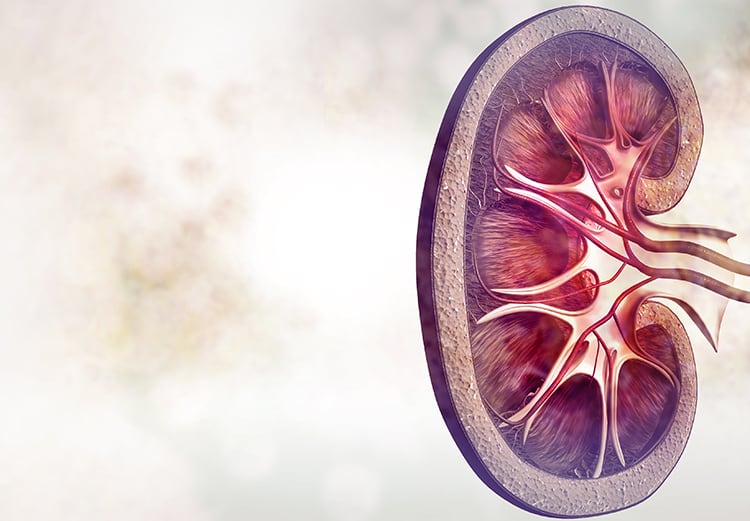




The kidneys play an essential role in filtering and cleansing the blood, as well as in maintaining the proper salinity of the blood, which, in turn, is essential not only for optimal cellular function, but for survival as a whole. One cannot live for more than a week without kidney function.
A Genius Invention of Nature
The kidneys are a great achievement of biological engineering. It is nearly impossible for the kidneys to identify all of the molecules that must be eliminated, but it is simple to eliminate all of them and then selectively recapture what the body needs. That’s how the kidneys work. In a nutshell, as the blood passes through the kidney, a lot of water leaks out along with minerals and other chemicals dissolved in the blood. This water is then recaptured by osmosis, along with nutrients and key minerals like potassium, sodium, phosphorus and calcium. In this manner, what the body doesn’t need ends up being eliminated in the urine, and the balanced retention of specific minerals helps maintain the blood’s salinity and pH.
Kidney Failure is a Secondary Problem
Any dysfunction of the kidneys is of primary importance, but kidney problems normally do not occur unless something else goes wrong; they are secondary problems. The main causes of kidney problems are high blood pressure that overpowers the small structures of the kidneys and diabetes that overloads the kidneys with long-term exposure to Advanced Glycation End products (AGEs). AGEs are formed when excess glucose in the blood reacts with proteins. The resulting AGEs are filtered by the kidneys, but long-term exposure to AGEs leads to a form of sclerosis of the kidneys.[1] So the first steps in maintaining good kidney health are to maintain a good cardiovascular health, to not develop diabetes, and to avoid exposure to toxins that can damage the kidneys.
Stem Cells and Kidney Function
When kidney function has begun to decline, there is little that medicine can do. The only approach is to reduce the burden on the kidneys by reducing blood pressure, controlling blood glucose, and relieving the effects of poor kidney function such as water accumulation and swelling, but no matter the case, it is a downward spiral.
When the potential of adult stem cells was revealed in the early 2000’s, scientists began to look at the potential use of stem cells to improve kidney function. As with the heart, the brain and the pancreas, the kidneys are not traditionally known to have the ability to repair or regenerate. But scientists rapidly discovered that like the brain and heart, stem cells have the ability to migrate to the kidneys and become functional cells of the kidneys.[2]
What does cholesterol do?
At some point, we need to candidly look at this overall therapeutic strategy and reach the conclusion that the cholesterol-approach to cardiovascular disease is simply not working. It is undeniable that cholesterol plays a critical role in the etiology of vascular diseases, but it is not the cause, it is a mere participant. As extensively documented in numerous articles and scientific reviews, cholesterol does not simply accumulate in the arterial lining. The process initially begins by a microscopic lesion that slowly gets infiltrated with macrophages, which in turn accumulates oxidized cholesterol to become “foam cells”. As they form, these foam cells become inflammatory and create havoc in the local tissue, triggering the death of smooth muscle cells and disrupting the collagen matrix. The cumulation of all these phenomenon leads to the formation of atherosclerotic plaques, increased blood pressure and ultimately, atherosclerosis.
Check more Organ Systems in our interactive tool
Endogenous Stem Cell Mobilization (ESCM) Can Support Kidney Function
Understanding that stem cells can become kidney cells and that this phenomenon is taking place naturally in the body, scientists began to study whether simply enhancing the release of one’s own bone marrow stem cells could help improve kidney function.
Several studies have indeed documented that stimulating the release of stem cells from the bone marrow can help improve kidney functions, though the actual mechanism is still not fully understood.[3][4] While it is clear that many stem cells actually transform into cells of the kidney, it appears that a significant part of the repair process takes place through the secretion of growth factors by stem cells, which in turn stimulates the intrinsic ability of the kidney to repair.[5][6] In other words, the kidneys have the ability to regenerate, but for some reason this capacity remains dormant. As stem cells migrate into the kidneys, they secrete compounds that stimulate the ability of the kidneys to regenerate.
Conclusion
While the kidney remains an organ that is difficult to regenerate, tapping into the potential of adult stem cells provide great promise for people with kidney problems. In fact, the simple release of one’s own stem cells using a natural stem cell enhancer could help improve kidney function.[7]
Sources
[1] Advanced glycation end products and the kidney.
Bohlender JM, Franke S, Stein G, Wolf G.
Am J Physiol Renal Physiol. 2005 Oct;289(4):F645-59.
[2] Bone marrow contributes to renal parenchymal turnover and regeneration.
Poulsom R, Forbes SJ, Hodivala-Dilke K, Ryan E, Wyles S, Navaratnarasah S, Jeffery R, Hunt T, Alison M, Cook T, Pusey C, Wright NA.
J Pathol. 2001 Sep;195(2):229-35.
[3] Bone marrow stem cells contribute to healing of the kidney.
Poulsom R, Alison MR, Cook T, Jeffery R, Ryan E, Forbes SJ, Hunt T, Wyles S, Wright NA.
J Am Soc Nephrol. 2003 Jun;14 Suppl 1:S48-54.
[4] Stem Cell Mobilizers: Novel Therapeutics for Acute Kidney Injury.
Xu Y, Zeng S, Zhang Q, Zhang Z, Hu X.
Curr Protein Pept Sci. 2017;18(12):1195-1199.
[5] Contribution of stem cells to kidney repair.
Bussolati B, Hauser PV, Carvalhosa R, Camussi G.
Curr Stem Cell Res Ther. 2009 Jan;4(1):2-8.
Stokman G, Leemans JC, Claessen N, Weening JJ, Florquin S.
J Am Soc Nephrol. 2005 Jun;16(6):1684-92.
[7] The Therapeutic Potential of Stimulating Endogenous Stem Cell Mobilization. In: Tissue Regeneration – From Basic Biology to Clinical Application. Drapeau C, Eufemio G, Mazzoni P, Roth GD and Strandberg, S. InTech Open, 2012.



